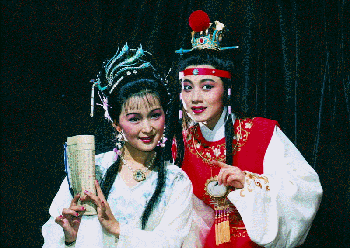Huangmei Opera was originally called "Huangmei tune" or "tea-picking opera." It was a folk opera that was formed in the regions of Anhui, Hubei, and Jiangxi at the end of the 18th century. One of the brands shifted to Huaining County, which was the center of Anqing, and mixed with its local art, using its local language to sing and narrate.

Consequently, it formed its own characteristics, called "Huai Tune," the predecessor of Huangmei Opera. At the middle of the 19th century, influenced by "Qingyang" and "Hui" tunes, Huangmei Opera developed into reserved copy opera. As such, it was gradually known and accepted by others.
At the beginning, Huangmei Opera was mainly characterized by singing over dancing. It had no fixed mode, but rather simply mimicked natural life. Some operas had the actions of tumbling and rushing, which was transferred from Qingyang and Hui tunes.
The Huangmei Opera performers mainly came from farmers and workers. And the acting material was usually borrowed from the audiences. It this period, Huangmei Opera was just an art form for the workers to entertain themselves.
Huangmei Opera can be divided into coloratura and pingci. Coloratura stages small operas, and is full of the sense of folk music. Pingci is the main melody of reserved copy opera, which uses narration and lyrics to express its meanings.
Some excellent operas of Huangmei Opera include: The Heavenly Maid and the Mortal, Goddess' Marriage, and Emperor's Female Son-in-law.
